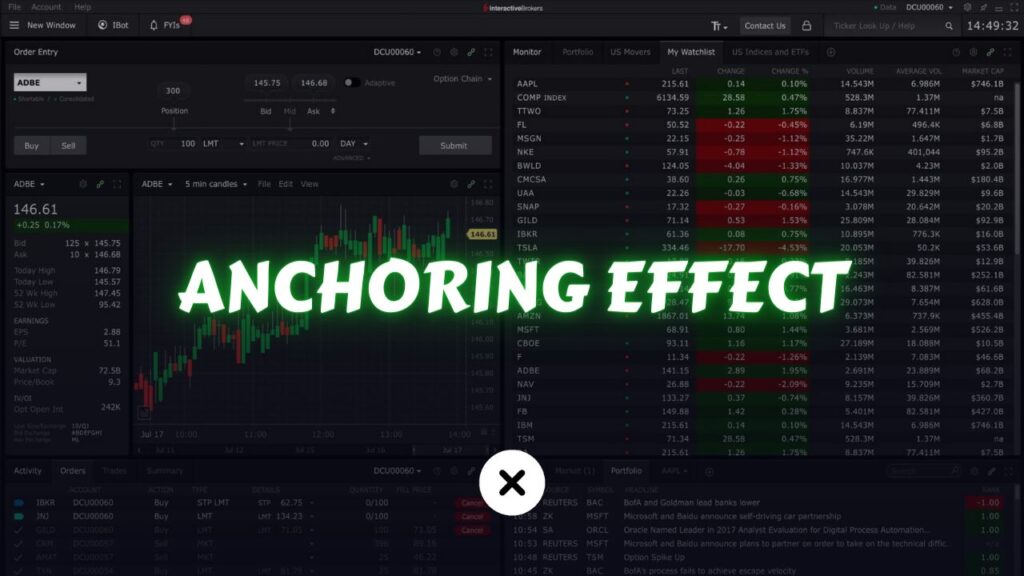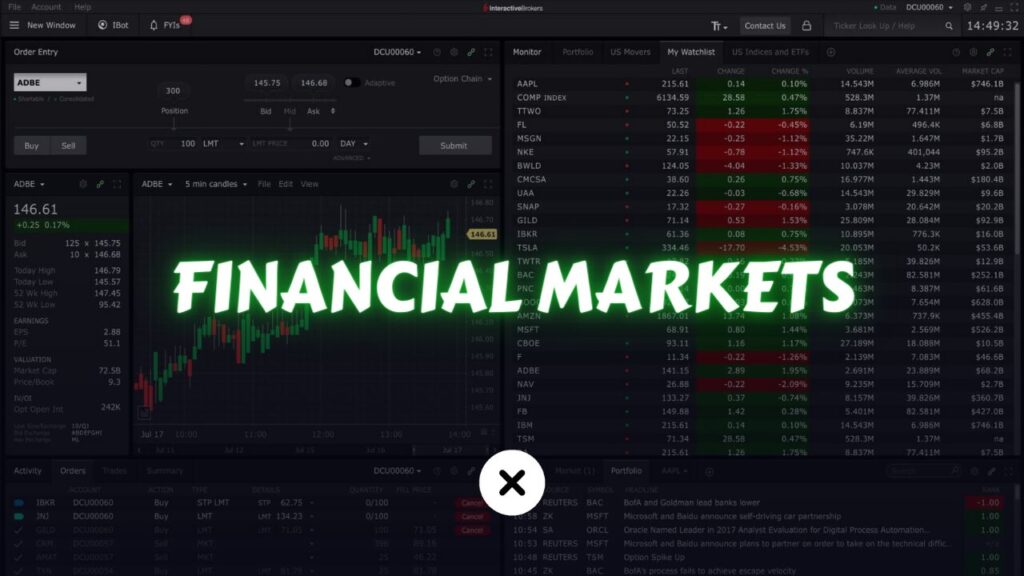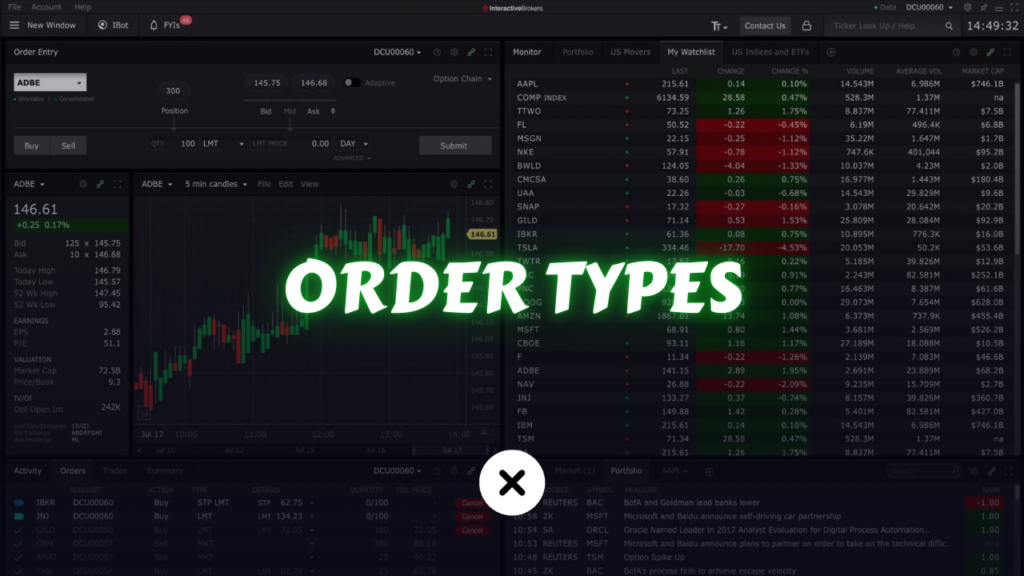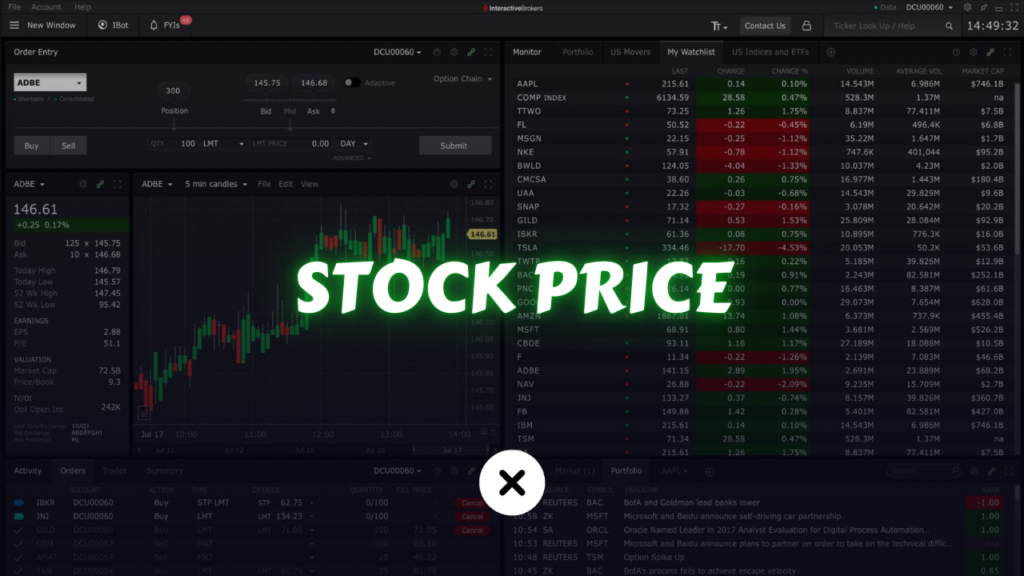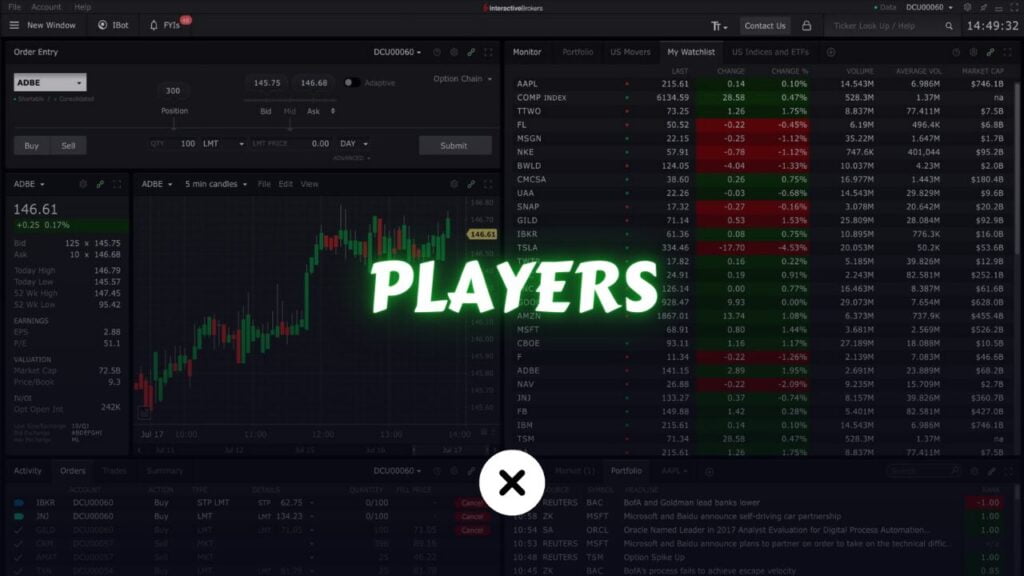The world of trading is fast-paced, highly volatile, and fueled by constant streams of data. Traders are bombarded with breaking news, economic reports, and fluctuating market charts all demanding rapid decision-making. However, amid this influx of information, cognitive biases often creep in, subtly influencing traders’ judgments without their awareness. One of the most persistent and costly biases is the Anchoring Effect in Trading.
The Anchoring Effect occurs when traders fixate on an initial price point or reference value the “anchor” and allow it to disproportionately shape their subsequent decisions. Instead of objectively analyzing evolving market conditions, traders often remain attached to their original expectations, even when new data contradicts them.
For example, if you purchased a stock at $100, you might perceive this price as its “true value” or your psychological break-even point. Even if market conditions change and the stock’s fair value shifts to $80 or $120, you may hesitate to adjust your strategy accordingly. This fixation can lead to poor stop-loss placement, mistimed entries or exits, and missed profit opportunities all of which can severely impact your trading performance.
In this comprehensive guide, we will explore the Anchoring Effect in Trading, dissecting why it occurs, how it influences your profits, and, most importantly, how to overcome it. With real-world examples and proven strategies, you’ll gain the knowledge needed to break free from this bias, make more rational trading decisions, and improve your overall market performance.oved profitability.
Table of Contents
What Is the Anchoring Effect?

The Anchoring Effect is a well-documented cognitive bias that occurs when people rely too heavily on an initial piece of information, or anchor, to make subsequent judgments and decisions. Once this anchor is set, it tends to bias future evaluations. This phenomenon was first extensively studied by psychologists Daniel Kahneman and Amos Tversky, who highlighted how individuals cling to initial estimates or information, even when more accurate data becomes available.
How Anchoring Works in General
- Initial Value or Information
The first piece of data you encounter becomes your reference point. For instance, in everyday life, if someone tells you a laptop is worth $1,500, you’ll use that as the benchmark to judge future laptop deals. - Subsequent Adjustments are Insufficient
When newer data arrives—like finding a similar laptop for $1,000—you may adjust your perceived fair value downward, but often not enough. Hence, you might believe $1,200 or $1,300 might still be a “good price,” even though further research might reveal competitive offers at $800.
Anchoring in Trading Context
- Reference Prices
In trading, the initial price at which you encounter or purchase an asset often becomes an emotional and psychological anchor. If you bought a stock at $50, your natural inclination might be to see $50 as the “correct” or “fair” price, even as the market dynamics change drastically. - Analyst Forecasts
When analysts or financial news outlets discuss a “price target,” those forecasts can become powerful anchors for both retail and institutional traders. This might cause traders to hold a position longer than they should or exit prematurely if the asset approaches that target. - News Headlines
Sometimes, a sensational headline sets a reference point in traders’ minds—like when a major news outlet claims a particular sector is “the future.” That reference might overshadow subsequent negative indicators or contradicting evidence.
Key Insight: The anchoring bias does not disappear simply because you are aware of it. It requires consistent effort and conscious strategies to mitigate its effects.
Why Does Anchoring Occur in Trading?

The anchoring bias is a byproduct of how our brains are wired to process information. We are constantly bombarded with data, and to avoid mental overload, our brains use shortcuts—known as heuristics. These shortcuts can be helpful in everyday decision-making but can prove costly in the complex environment of financial markets.
Information Overload
Modern markets generate enormous streams of data every second—price charts, technical indicators, economic reports, social media sentiment, and more. Traders often look for ways to make quick decisions, and the simplest approach is to latch onto a piece of information they deem important. This strategy can backfire when the anchor is outdated or irrelevant.
Emotional Attachment
Money and emotions are deeply intertwined. When you purchase a stock at a certain price, that number becomes personal. You might feel “committed” to the price, leading to an irrational attachment that hinders objective analysis if the market shifts.
- Fear: You fear accepting a loss if you move away from your anchor (e.g., selling below your purchase price).
- Greed: You become overly optimistic that the anchor price will be reached (or surpassed) because you want to secure higher profits.
Social Influence
The opinions of prominent analysts, influencers, or trading communities can form mental anchors. When a respected figure projects Bitcoin’s price to hit $100,000 by year’s end, that figure can become the anchor for many traders. Market participants then interpret news, charts, and fundamental data through this lens, sometimes ignoring contradictory signals.
Lack of a Systematic Approach
Without a well-defined trading system, traders often gravitate toward “rules of thumb” or incomplete pieces of data. Anchoring occurs when a trader lacks a consistent process for evaluating market information. The result is an overreliance on the first data point encountered.
Psychological Underpinnings: How Our Minds Get Anchored

To fully appreciate the impact of anchoring in trading, it’s crucial to understand the psychological processes behind it. Two main concepts help explain anchoring:
- Heuristics: Mental shortcuts that simplify decision-making under conditions of uncertainty.
- Cognitive Biases: Systematic errors in thinking that affect the decisions and judgments that people make.
Heuristics: The Human Brain’s “Efficiency Mode”
- Limited Attention
Our brains can only process so much information at once. In a chaotic environment like financial markets, focusing on a single “anchor” can seem like a convenient filter. - Rapid Decision-Making
Speed is often essential in trading. Under time pressure, relying on an anchor is a quick way to form a conclusion—“If this price was good before, it’s good now.”
Cognitive Biases: Distorting Reality
- Confirmation Bias: We tend to seek out information that confirms our pre-existing beliefs. If your anchor is a certain price level, you might look for news or analyses that support that price rather than considering evidence to the contrary.
- Overconfidence Bias: Traders sometimes overestimate their ability to interpret market signals correctly. If you anchored on an idea that stock XYZ will rise, your confidence could blind you to signs of a potential drop.
- Loss Aversion: This bias explains why losses hurt more than gains feel good. Anchoring often ties into loss aversion because traders who see a downward move from their anchor experience heightened emotional stress, making them more likely to “hope” rather than “act” decisively.
Emotional Triggers and Anchoring
- Hope, Fear, and Greed
Emotions can amplify the anchoring effect. When prices approach your anchor, you may feel hope if you’re looking to break even, or greed if you believe you’re heading into profit territory. Conversely, fear sets in if the market moves away from your anchor, potentially freezing your decision-making process. - Ego Defense
Admitting you anchored on an incorrect piece of information can feel like admitting personal error. Many traders inadvertently protect their ego by doubling down on the original anchor rather than adapting to new market realities.
Important Note: Recognizing these underpinnings won’t instantly eliminate the anchoring bias. It’s a constant battle against your natural tendencies. However, awareness is the first critical step toward mitigation.
Common Scenarios of Anchoring in Trading
Anchoring can manifest in various scenarios in trading, often with detrimental consequences. Let’s explore a few common situations where traders might succumb to the anchoring effect:
1. Holding onto Losing Trades
- Scenario: You purchased a stock at $100. It drops to $80 due to deteriorating market conditions or poor corporate earnings. Instead of cutting losses, you remain fixated on the $100 anchor, believing the stock “must” return to that level eventually.
- Outcome: You might hold onto the losing trade far longer than you should, tying up capital and risking further losses.
2. Missing Out on Profitable Trades
- Scenario: Your initial research set a price target of $120 for a particular stock. When it exceeds $120 and hits $130, you immediately sell, anchored to your earlier forecast and believing it cannot go higher.
- Outcome: The stock might continue rallying to $150 or beyond, and you miss out on significant profits because you anchored on a target price that you believed to be the maximum reasonable valuation.
3. Improper Stop-Loss Placement
- Scenario: You enter a trade at $50 and decide your stop-loss at $45, primarily because $45 was mentioned in a stock recommendation article. You don’t reevaluate this stop-loss as new data emerges.
- Outcome: If the market volatility spikes, that stop-loss might be poorly aligned with the stock’s actual support/resistance levels. You could be stopped out prematurely or risk holding through volatile swings unnecessarily.
4. Overvaluing or Undervaluing Assets
- Scenario: A famous analyst states that a technology stock is “worth at least $300.” You buy shares at $280, anchored on the idea that $300 is a fair valuation. Despite worsening sector fundamentals, you continue to believe the stock will reach $300.
- Outcome: The stock may be worth closer to $200 based on current conditions, leading to a potential loss while you remain emotionally tied to the $300 anchor.
5. Blindly Following News Headlines
- Scenario: A headline says, “Oil prices to skyrocket due to supply cuts.” You buy oil futures anchored on the idea that supply cuts automatically mean higher prices.
- Outcome: You ignore other variables—such as weakening global demand or alternative energy supply expansions—that might cap or reverse oil price gains. This oversight can lead to trades that are misaligned with actual market conditions.
In all these scenarios, the common thread is an unwillingness or inability to adapt to new and contradicting information. The anchor becomes the lens through which every subsequent piece of data is viewed—a lens that can easily distort reality.
How Anchoring Affects Your Profits
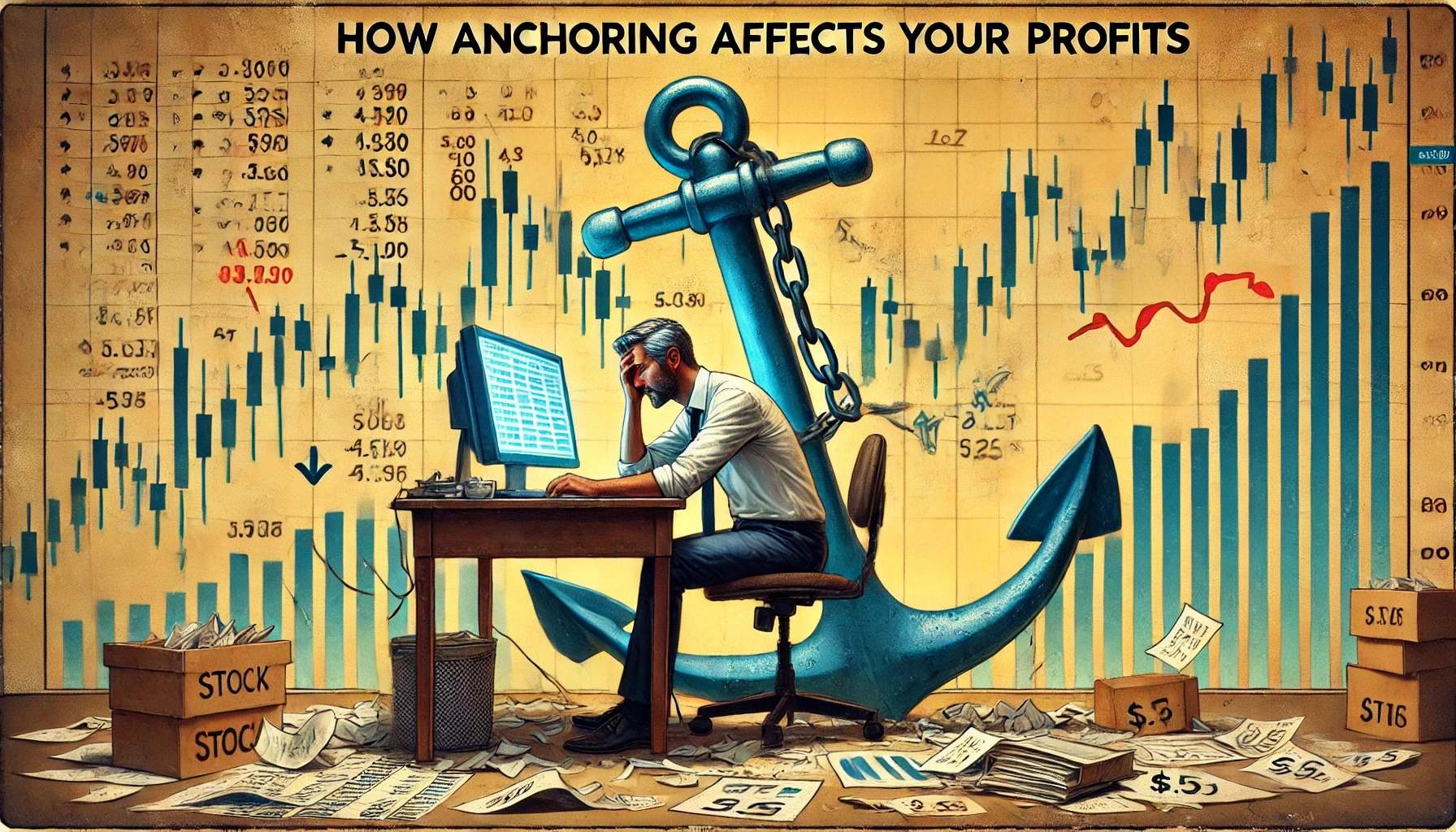
The ultimate measure of success in trading is your bottom line. Even a small deviation in entry/exit points or position sizing can significantly influence your overall performance. Here’s how the anchoring bias can chip away at your profits—or even generate losses:
1. Delayed Adaptation
Financial markets are dynamic. Economic indicators, political events, technological shifts—any of these can drastically alter an asset’s valuation. Clinging to an anchor slows your adaptation process. By the time you reevaluate, you could have missed optimal entry or exit points.
- Example: In a fast-moving market, a stock could jump from $50 to $60 within hours. If your anchor was $45 (perhaps an analyst’s “fair value” stated weeks ago), you might dismiss the upward move as temporary and refuse to buy, missing out on rapid gains.
2. Skewed Risk Management
Stop-loss orders and position sizing are cornerstones of risk management. Anchoring can lead to placing stop-losses or take-profit targets at suboptimal levels.
- Example: A trader anchored on a specific support level that was relevant in the past market conditions could end up setting a stop-loss too tightly, getting stopped out repeatedly in normal market fluctuations.
3. Opportunity Cost
Money tied up in an anchored position is money that isn’t being utilized elsewhere. If you remain stuck in a losing trade or exit too early from a winning one due to anchoring, you miss out on opportunities in other stocks or markets.
- Example: If you refuse to sell a losing position anchored at $80 to realize a small loss, you might miss an opportunity to deploy that capital in a stock that’s showing strong bullish signals and potential for quick gains.
4. Emotional Stress Leading to Bad Decisions
Anchoring-induced stress can cause you to deviate from your trading plan. Emotional decisions made under stress often compound mistakes.
- Example: Watching a position inch away from your anchor could induce panic selling or revenge trading—both of which often lead to further losses.
5. Reinforcing Other Biases
Anchoring can exacerbate other cognitive biases such as confirmation bias (only seeking data that supports your anchor) or status quo bias (resisting change). This interweaving of biases can lead to a vicious cycle where your trading decisions become increasingly detached from market reality.
In short, the anchoring effect can be a silent profit killer. Without a systematic method to counter anchoring, traders can fall into repetitive patterns of loss, frustration, and missed opportunities.
Strategies to Overcome Anchoring
Anchoring is deeply ingrained in our cognitive processes, so eliminating it entirely is difficult. However, several strategies can help you mitigate its impact and make more objective, data-driven trading decisions.
1. Pre-Trade Planning and Checklists
Action: Create a structured approach before entering any trade. Determine your entry price, stop-loss level, profit target, and the technical or fundamental criteria that justify these decisions.
- Why It Works: By defining these parameters beforehand, you reduce the influence of any single piece of information. You also have a reference to measure whether your trade assumptions are still valid as new data surfaces.
Example Checklist Items:
- Current market trend (bullish, bearish, or sideways).
- Key support/resistance levels based on technical analysis.
- Relevant economic indicators or earnings reports.
- A clear stop-loss level tied to a chart pattern or fundamental change.
2. Re-Evaluate Anchors at Defined Intervals
Action: Set specific times—daily, weekly, or monthly—to revisit your anchors and reassess whether they remain valid based on the latest data.
- Why It Works: Regular checkpoints help counteract the inertia of anchoring. By committing to periodic reassessments, you force yourself to look at new information objectively.
Example:
- Every Friday, review the week’s major economic events, earnings, and price action. Adjust your trading plan accordingly if contradictions arise.
3. Use Multiple Time Frames and Analytical Methods
Action: Combine technical analysis, fundamental analysis, and sentiment analysis to form a comprehensive view. Likewise, look at different chart time frames (e.g., daily, weekly, monthly) before making a decision.
- Why It Works: Anchoring often happens because of a single data point—like a “fair value” or a certain support level on a 5-minute chart. Considering multiple time frames and analyses can reduce overreliance on a singular anchor.
Example:
- If daily charts suggest an uptrend but weekly charts show a significant resistance overhead, balance these conflicting signals before anchoring on any single price level.
4. Develop a Mindful Trading Routine
Action: Incorporate mindfulness or brief mental resets into your trading routine. This could involve taking a 1-minute break to breathe deeply and reassess your emotional state before executing a trade.
- Why It Works: Emotional regulation is critical to combating cognitive biases. A calmer, more aware mind is better at recognizing and questioning irrational anchors.
Example:
- Before adjusting your stop-loss, pause and ask: “Am I doing this because the market conditions changed or because I’m anchored to my original target?”
5. Implement Automated Alerts or Trading Systems
Action: Use technology to reduce human bias. Automated alerts can notify you when the market crosses key levels, while algorithmic or mechanical trading systems can remove much of the emotional element from decision-making.
- Why It Works: Automation imposes discipline, reducing the chance that you’ll ignore new data simply because you’re anchored on a specific viewpoint.
Example:
- Set alerts on your trading platform that automatically trigger when the price moves 5% above or below your current anchor. Use these alerts as a prompt to re-evaluate your position.
6. Practice Scenario Analysis and “If-Then” Planning
Action: Before entering a trade, outline multiple scenarios. “If the stock breaks through this support, then I will exit,” or “If the economic data this week is worse than expected, then I will reduce my exposure.”
- Why It Works: Having a game plan for multiple outcomes reduces the risk of latching onto a single anchor. It also helps you stay flexible and responsive to actual market conditions rather than clinging to one reference point.
Example:
- “If the S&P 500 drops below 3,800 amid rising inflation data, I will shift to a more defensive sector or hedge my positions with index puts.”
Best Practices for Minimizing the Anchoring Effect
While the strategies above are key to overcoming anchoring, embedding them in your daily trading routine is essential. Here are some best practices to ensure consistency and improve your overall trading performance:
1. Journal Your Trades
How: Maintain a trading journal detailing the reasons for each trade, including the anchor points you considered (e.g., initial purchase price, price targets, or analyst estimates). After each trade closes, revisit the journal to assess whether anchoring influenced your decisions.
Why: A trade journal creates accountability and offers insight into recurring mistakes. Reviewing your notes can help you see patterns like consistently refusing to cut losses below a certain price because you anchored on your entry point.
2. Seek Independent Analysis
How: Diversify your sources of information. Don’t rely solely on the same analyst, forum, or financial news channel. Engage with professionals or communities that challenge your viewpoints.
Why: Hearing a variety of opinions can loosen the hold of a single anchor. It forces you to weigh different perspectives, increasing the likelihood of making balanced, evidence-based decisions.
3. Combine Fundamental and Technical Analysis
How: Conduct fundamental research (company earnings, industry trends, macroeconomic indicators) alongside technical chart analysis (price trends, volume, candlestick patterns). Merge both findings into a cohesive trading strategy.
Why: Relying on only one form of analysis can breed anchoring. A thorough approach that includes both fundamental and technical factors reduces the chance that a single data point (like “fair value” or “RSI level”) becomes your sole anchor.
4. Use Probabilistic Thinking
How: Shift from black-and-white thinking (“this stock must hit $100”) to probabilities (“there’s a 60% chance it will reach $100, 30% chance it will linger around $90, and 10% chance it could drop to $80 or lower”).
Why: Probabilistic thinking fosters flexibility. It acknowledges uncertainty and encourages ongoing evaluation of your assumptions—thus diluting the power of any one anchor.
5. Maintain a Balanced Mental State
How: Incorporate stress-management techniques, proper sleep, and regular exercise into your lifestyle. Emotional well-being can drastically improve your ability to stay objective in the face of market volatility.
Why: A high-stress, sleep-deprived, or anxious mind is more likely to fall prey to cognitive biases, including anchoring. Mental and physical well-being serve as your first line of defense against irrational thinking.
Case Studies & Real-Life Examples
Looking at how anchoring has played out in the real world can offer invaluable lessons. While every trader’s situation is unique, these examples highlight how easily we can get anchored and how to avoid it.
Case Study 1: Bitcoin Mania
- Scenario: In late 2017, Bitcoin surged from around $1,000 to nearly $20,000. The media hype led many traders to anchor on the $20,000 figure as the “new normal” or “fair value.”
- Outcome: When Bitcoin began to correct, dropping below $10,000, some traders refused to sell, believing prices “must” return to $20,000. The market eventually plunged to around $3,000 in 2018, causing massive losses for those who had anchored on the $20,000 peak.
- Lesson: In volatile markets, a record high or an all-time high can act as a dangerous anchor. Always monitor broader market signals, adapt to new information, and consider a range of possible outcomes.
Case Study 2: Meme Stock Frenzy
- Scenario: During the meme stock boom, certain heavily shorted stocks soared in price due to retail trading communities coordinating on social media platforms. Let’s take “Stock X,” which jumped from $5 to $50 almost overnight.
- Outcome: Many traders anchored on $50 as the “new normal.” When the price started to retract to $40, $30, and then $20, they held on, convinced it would rebound to $50 because “that’s what the internet said it’s worth.”
- Lesson: Viral hype and sensational social media narratives create strong anchors. Even though fundamentals might not support the lofty valuation, the community-driven anchor can be incredibly persuasive. Successful traders maintained caution, used trailing stop-losses, and avoided fixating on peak prices.
Case Study 3: Oil Price Shock
- Scenario: In 2020, oil prices experienced unprecedented volatility, even dipping below $0 for a short period due to demand collapse and storage constraints. A year later, oil rebounded above $70.
- Outcome: Traders who anchored on $0 or $20 as an “insane low” level might have missed the rebound because they believed the oil market was too unstable. Conversely, those anchored on $70 as the correct “mean” price may have ignored signals when the supply/demand equation changed again.
- Lesson: Extreme price events can create emotional anchors. In highly volatile commodities, it’s crucial to remain flexible, continuously reassess fundamentals (supply, demand, geopolitical factors), and update your anchors accordingly.
Anchoring vs Other Cognitive Biases
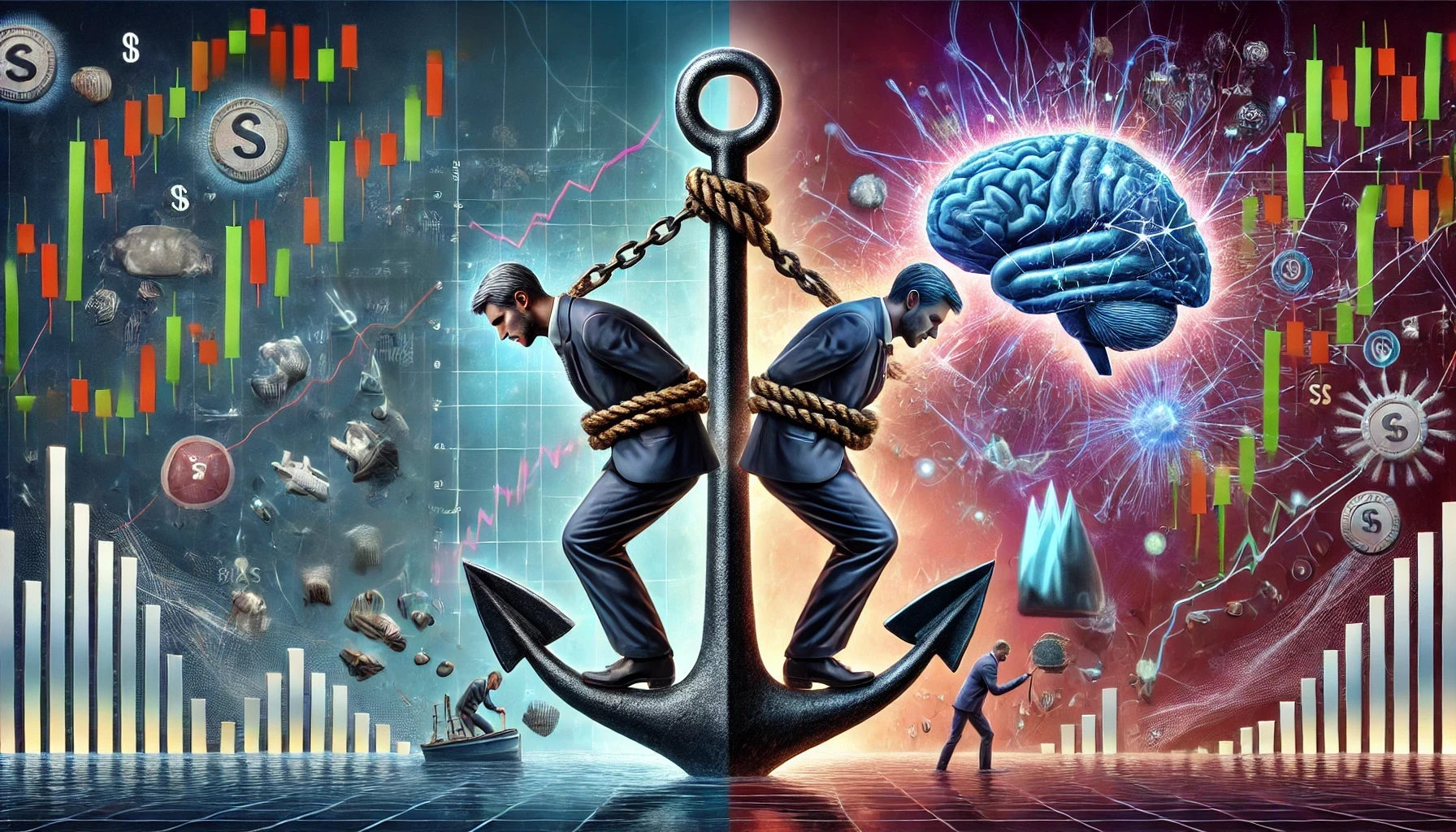
Anchoring rarely exists in isolation. It often interacts with other cognitive biases, making it even harder to identify and correct. Here are some closely related biases:
1. Confirmation Bias
- Definition: The tendency to search for, interpret, and remember information that confirms one’s preconceptions.
- Interaction with Anchoring: If you anchored on a specific target price, you might selectively read news articles that justify that price point, reinforcing your anchor.
2. Overconfidence Bias
- Definition: The tendency to have excessive belief in one’s own abilities or the accuracy of one’s predictions.
- Interaction with Anchoring: A trader who thinks they’ve done impeccable research on a particular stock might overly rely on their initial valuation, ignoring emerging red flags.
3. Recency Bias
- Definition: The tendency to give more weight to recent events or information compared to older data.
- Interaction with Anchoring: If the last data point or event you encountered sets a strong anchor, you might discount older, possibly more relevant information that paints a fuller picture.
4. Loss Aversion
- Definition: The fear of losses is stronger than the pleasure of equivalent gains.
- Interaction with Anchoring: When the market moves below your anchor price, the pain of realizing a loss might lead you to hold onto losing trades longer in the hope that prices will return to your anchor.
By understanding how anchoring interplays with these other biases, traders can adopt a more holistic approach to cognitive risk management. It’s often not enough to tackle anchoring alone—you need to stay vigilant against the entire ecosystem of biases that affect your thinking.
Conclusion: Mastering Your Mindset
The Anchoring Effect is one of the most insidious yet common cognitive biases in trading. It can stealthily influence your perception of fair value, your stop-loss placements, and your profit-taking strategies. Left unchecked, anchoring can lead to suboptimal trades, strained emotional states, and diminished profits.
However, awareness and intentional practice can go a long way toward mitigating its effects. By implementing strategies such as pre-trade checklists, periodic re-evaluation of market data, and probabilistic thinking, you can significantly reduce the detrimental impact of anchoring. Supporting practices like maintaining a detailed trading journal, seeking diverse viewpoints, and combining fundamental and technical analysis further solidify your defenses against this and other biases.
Ultimately, trading is as much about psychology as it is about numbers. Continual self-assessment and adaptation are required to stay profitable in dynamic markets. Cultivating mindfulness, emotional regulation, and cognitive flexibility will help you avoid getting trapped by an anchor that no longer fits the market reality.
Key Takeaways:
- Anchoring is Powerful but Manageable: Knowing about the bias is the first step; actively fighting it is where true skill lies.
- Structured Approaches Help: Checklists, scenario planning, and journaling can add discipline to your trading routine, making you less prone to snap judgments.
- Continuous Learning & Adaptation: The market changes; your anchored viewpoints should too. Stay flexible and open to new information.
- Holistic Bias Awareness: Recognize that anchoring often interacts with other biases, creating a web of psychological traps. A broad, vigilant approach is essential.
Master your mindset, and you’re well on your way to mastering the markets. By breaking free from mental anchors, you gain clarity, agility, and the potential to realize consistently higher trading profits. Implement the suggestions in this guide, and watch how your decision-making process becomes sharper and more aligned with actual market conditions—rather than old, irrelevant anchors.
